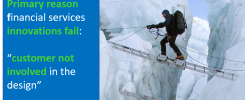“The web is fascinating and transformative but it’s an easy, flashy, get-rich-quick option to the hard graft of proper industry” says James Dyson. There is nothing wrong with gritty, even dirty, industries and we absolutely enjoy working with clients where things are hands-on made, distributed, grown, driven or fixed.
We are often brought in by Private Equity because they know that Customer Thinking provides an excellent platform for rapid, sustainable growth in down-to-earth businesses.
#1 Developing Customer Value
Often gritty businesses have been running for some time without any professional customer insight, although they employ deeply knowledgeable industry experts, and account managers will be visiting regularly – but that’s not enough.
The issue is that all too often customer understanding is based on inside-out thinking where the business thinks it knows what the customer wants rather than involving the customer in outside-in thinking where the offer is defined to add value in the eyes of the customer. It’s an important distinction because making assumptions on behalf of the customer leaves you vulnerable to missing the true pace of change, looking in the wrong direction, and suddenly finding yourself left behind whatever your level of industry expertise. Failing to check with customers leads to complacency, wasted effort on developments that customers don’t value and missed opportunities for customer-centred growth.

#2 The Pace of Change in B2B Markets is Accelerating
There is a change in expectations because your buyers are individuals who in another part of their lives are fully exposed to the full flood of consumer digital sophistication including fast, seamless online ordering and fulfilment, smartphone apps, account servicing dashboards and online support. They are starting to expect this from their B2B suppliers and this is quickly leading to new digital selling platforms which are replacing traditional face to face and telephone sales. Few business websites offer features to simplify transactions, create deep customer relationships and drive sales growth. (Salesforce reports 61% of B2B purchases start online and 80% of business buyers want a consumer-like digital experience).
Of course, B2B buyers act differently to consumers, taking a more rational and considered approach and with decisions shared across a number of roles. Business buyers often have complex specific requirements: price and terms, service levels and reliability in use, safety and logistical needs. Business relationships are also more complex with high levels of trust and often a desire for long-term ongoing support and purchasing cycles.
Digital solutions that add a consumer level of convenience and speed may not be simple to implement on a legacy B2B environment but more change is coming with technologies such as Mobile 5G, Blockchain, Internet of Things (IoT), 3D printing, AI that are already here. The potential is to innovate new possibilities that add a new level of customer value and in doing so close the door to unwelcome competitors operating from a different cost base and revenue model.
B2B buyers are starting to use the technology in their own businesses to improve their leverage on suppliers by for instance using analytics to benchmark service and product performance from suppliers in real-time. Analytics enable sellers to present timely, highly customised offers that build on customer data and anticipate requirements.
There is a generational change taking place in the workforce as digital native millennials start to occupy front line purchasing and usage roles.
#3 Unlocking Growth Through Customer Thinking
What is the process for breaking out of inside-out thinking and unlocking growth and profit? The first step is to take a close look at what you know, what you think you know and what you don’t know. Most businesses find when they take this audit that much of their assumptions that they use to make business decisions about customers are not actually based on evidence or data and that there are contradictory views. We would suggest you look at all sources of information and talk to front line staff.
It will be important as a next step to talk directly to customers. There are many insight techniques for this, but the gold standard is a direct conversation facilitated with professional expertise. Often clients are sceptical that busy buyers will be prepared to talk to us – but the opposite is the case. Buyers love to talk peer to peer with us about their requirements and challenges and the positive conversation is in itself a platform for increased sales, paying directly for our work.
Curiosity has developed affordable proven methodologies that make world-class customer insight accessible where budgets are tight. An example is the QQ approach which combines a statistically significant quantitative survey with deep peer dialogue into an affordable and rapidly delivered package.
You may find that customers can be segmented for instance into one-click smaller transactional purchasers, purchasers who will be analytic in their assessment of the merits of your product and will require a depth of technical data, and solutions purchasers who require a high degree of customisation and support.
Smart businesses know that the strongest source of growth and profit is the customer, not the product. This is because a customer who is fully engaged with your business will provide you with extra sales, more use, more spend and longer tenure. In fact, they may become advocates and recruit customers for you. This is why in B2B marketing developing deep relationships with customers will always payback.
To ensure the segmented value proposition is soundly based we recommend you bring the customer into a collaborative design where ideas are jointly developed that create mutual value. It is likely that the top-tier of customers will welcome an informal strategic partnership relationship where bespoke solutions are developed jointly for the long term. As technology draws buyers and sellers closer, they discover new opportunities to create value by working together.

#4 New Ways of Working
Moving towards a customer-centric operating model may imply a radical culture shift requiring new ways of working and thinking, breaking down traditional silos to form cross-functional teams charged with optimizing every interaction between customers and the company. Organising around the customer brings a shared focus and dynamism.
There are proven techniques using agile methods, developing minimum viable products (MVPs) that deliver quick, tangible customer benefits with little up-front investment. To keep on track, teams work toward clearly defined targets, such as improving website functionality or strategic partnership sales engagement. By focusing on outcomes, they can monitor and adjust KPIs that measure progress toward organizational goals — such as better customer acquisition, satisfaction, retention and thereby delivering growth.
Understanding that business growth comes from continually building value as perceived by the customer is the essence of Customer Thinking.
BeyondCuriosity is a specialist insight and innovation agency enabling innovation and growth.
Recent clients include:

For more information call or email 07957686366 chris@beyondcuriosity.com



